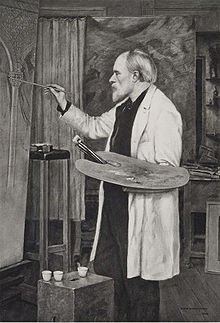Edward Burne-Jones | |
|---|---|
 Photogravure of a portrait of Edward Burne-Jones by his son Philip Burne-Jones, 1898 | |
| Born | Edward Coley Burne Jones 28 August 1833 Birmingham, England |
| Died | 17 June 1898 (aged 64) London, England |
| Known for | Painting |
| Movement | |
| Spouse | |
| Partner | Maria Zambaco (1866–1869) |
| Relatives |
|
Sir Edward Coley Burne-Jones, 1st Baronet, ARA (/bɜːrnˈdʒoʊnz/;[1] 28 August 1833 – 17 June 1898) was an English painter and designer associated with the Pre-Raphaelite Brotherhood's style and subject matter.[2]
Burne-Jones worked with William Morris as a founding partner in Morris, Marshall, Faulkner & Co in the design of decorative arts.[3] His early paintings show the influence of Dante Gabriel Rossetti, but by 1870 he had developed his own style. In 1877, he exhibited eight oil paintings at the Grosvenor Gallery (a new rival to the Royal Academy). These included The Beguiling of Merlin. The timing was right and he was taken up as a herald and star of the new Aesthetic Movement.
In the studio of Morris and Co. Burne-Jones worked as a designer of a wide range of crafts including ceramic tiles, jewellery, tapestries, and mosaics. Among his most significant and lasting designs are those for stained glass windows the production of which was a revived craft during the 19th century. His designs are still to be found in churches across the UK, with examples in the US and Australia.
- ^ "Burne-Jones". Collins English Dictionary.
- ^ Lehnebach, Carlos A.; Regnault, Claire; Rice, Rebecca; Awa, Isaac Te; Yates, Rachel A. (1 November 2023). Flora: Celebrating our Botanical World. Te Papa Press. pp. 94–95. ISBN 978-1-9911509-1-2.
- ^ Cite error: The named reference
milwas invoked but never defined (see the help page).